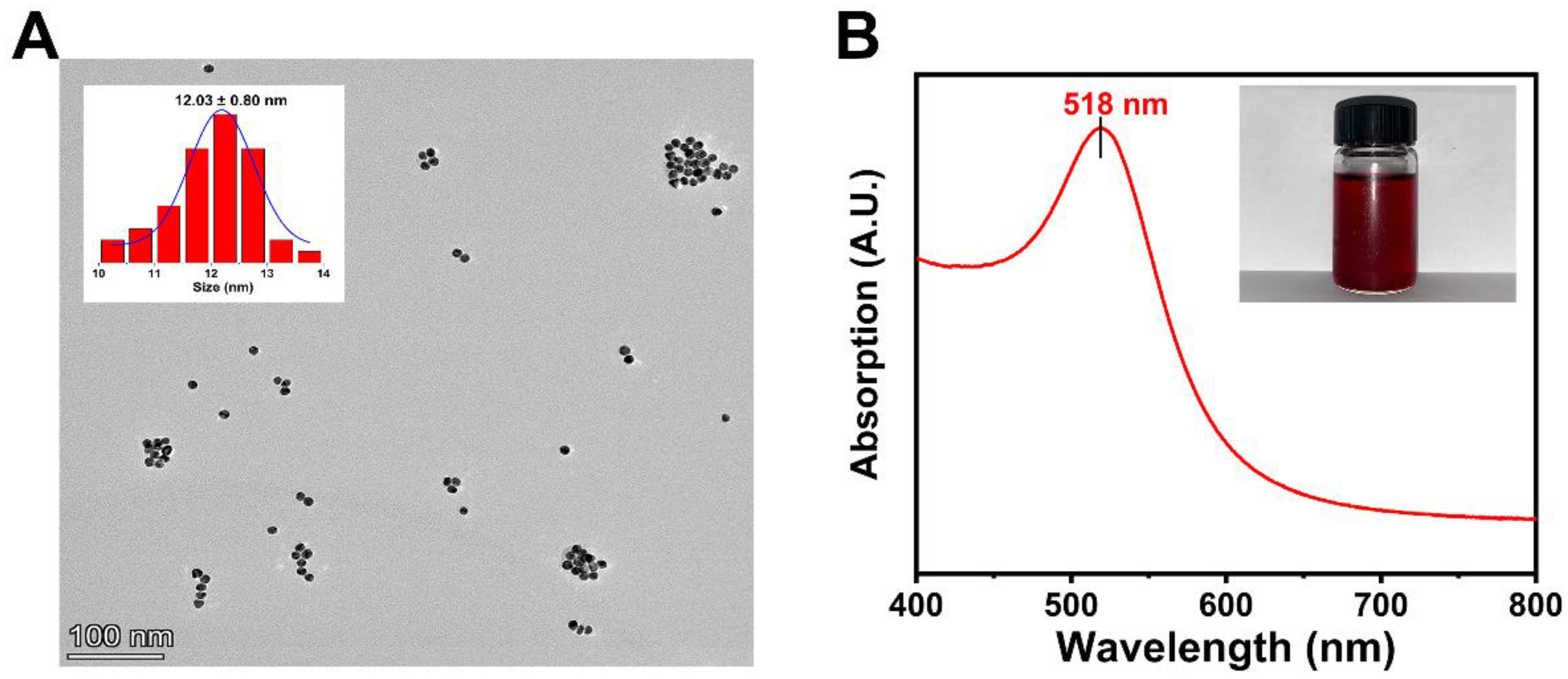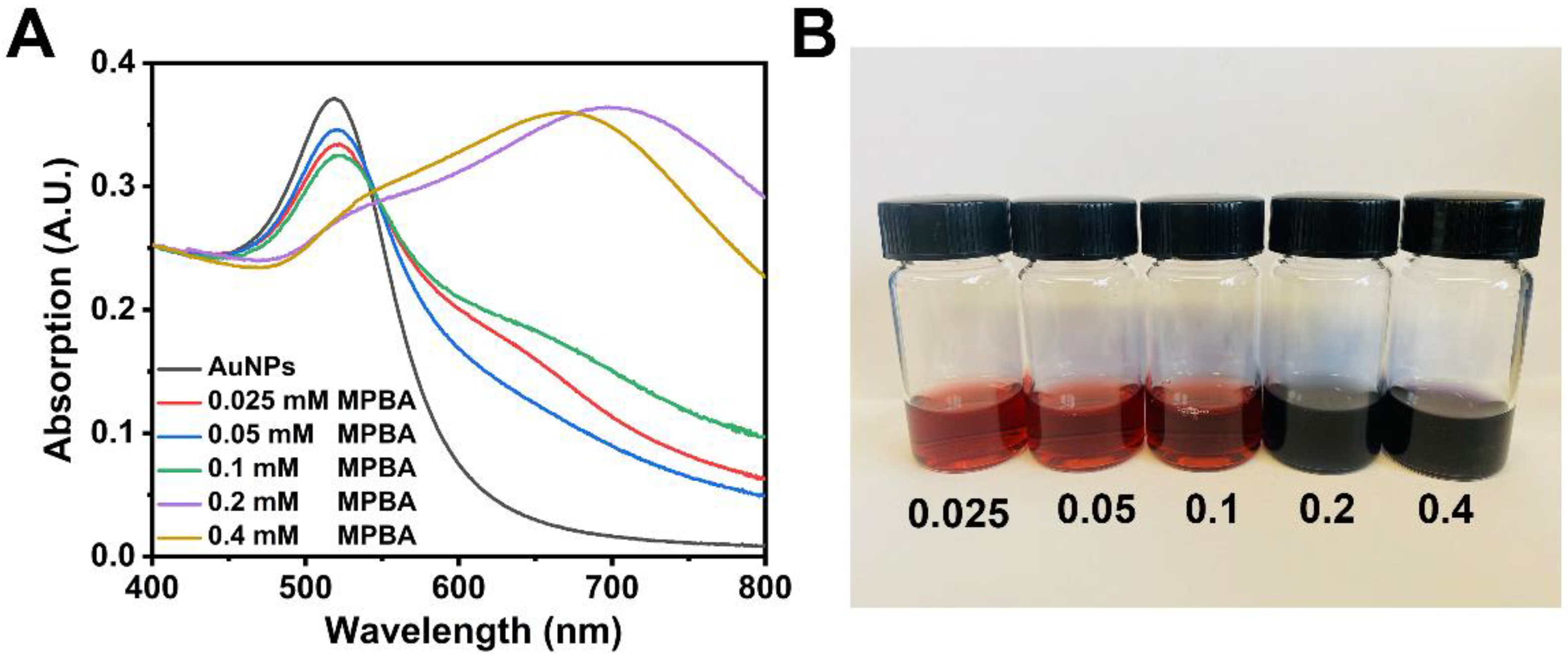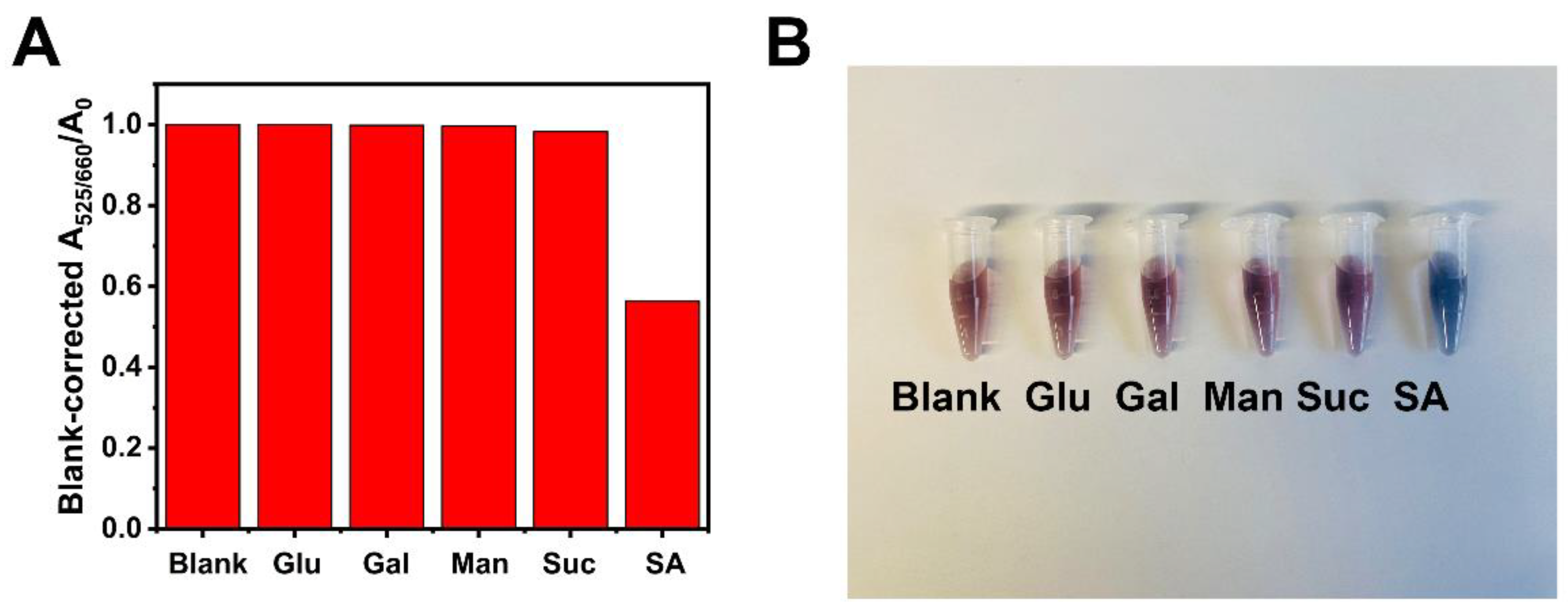A Schematic Colorimetric Assay for Sialic Acid Assay Based on PEG-Mediated Interparticle Crosslinking Aggregation of Gold Nanoparticles
Abstract
:1. Introduction
2. Materials and Methods
2.1. Chemical Reagents
2.2. Characterizations
2.3. AuNPs Synthesis
2.4. Preparation of 4-MPBA-AuNPs and 4-MPBA-AuNPs@PEG400
2.5. Colorimetric Sensing Analysis of SA
2.6. Real Sample Analysis
3. Results and Discussion
3.1. Characterization of the AuNPs
3.2. Characterization of 4-MPBA-AuNPs and 4-MPBA-AuNPs@PEG400
3.3. Optimization of the Assay Conditions
3.3.1. Effect of the Amount of 4-MPBA
3.3.2. Effect of PEG on Sensing Performance
3.3.3. Optimization of Reaction Time
3.4. Assay Performance of the 4-MPBA-AuNPs@PEG400 Sensing System for SA Detection
3.4.1. The Linear Dynamic Range and Limits of Detection
3.4.2. Selectivity of the Sensing System
3.4.3. Detection of Real Sample
4. Conclusions
Supplementary Materials
Author Contributions
Funding
Institutional Review Board Statement
Informed Consent Statement
Data Availability Statement
Conflicts of Interest
References
- Nguyen, L.; McCord, K.A.; Bui, D.T.; Bouwman, K.M.; Kitova, E.N.; Elaish, M.; Kumawat, D.; Daskhan, G.C.; Tomris, I.; Han, L. Sialic acid-containing glycolipids mediate binding and viral entry of SARS-CoV-2. Nat. Chem. Biol. 2022, 18, 81–90. [Google Scholar] [CrossRef] [PubMed]
- Ono, K.; Sanada, Y.; Kimura, Y.; Aoyama, S.; Ueda, N.; Katayama, T.; Nagahama, K. A thin hydrogel barrier linked onto cell surface sialic acids through covalent bonds induces cancer cell death in vivo. Biomater. Sci. 2020, 8, 577–585. [Google Scholar] [CrossRef] [PubMed]
- Zhou, Y.; Dong, H.; Liu, L.; Liu, J.; Xu, M. A novel potentiometric sensor based on a poly (anilineboronic acid)/graphene modified electrode for probing sialic acid through boronic acid-diol recognition. Biosens. Bioelectron. 2014, 60, 231–236. [Google Scholar] [CrossRef] [PubMed]
- Sun, X.-L. The role of cell surface sialic acids for SARS-CoV-2 infection. Glycobiology 2021, 31, 1245–1253. [Google Scholar] [CrossRef]
- Zhang, X.; Liu, Y.; Liu, L.; Li, J.; Du, G.; Chen, J. Microbial production of sialic acid and sialylated human milk oligosaccharides: Advances and perspectives. Biotechnol. Adv. 2019, 37, 787–800. [Google Scholar] [CrossRef]
- Wang, J.; Zhao, L.; Yan, B. Indicator displacement assay inside dye-functionalized covalent organic frameworks for ultrasensitive monitoring of sialic acid, an ovarian cancer biomarker. ACS Appl. Mater. Interfaces 2020, 12, 12990–12997. [Google Scholar] [CrossRef] [PubMed]
- Matsumoto, A.; Sato, N.; Kataoka, K.; Miyahara, Y. Noninvasive sialic acid detection at cell membrane by using phenylboronic acid modified self-assembled monolayer gold electrode. J. Am. Chem. Soc. 2009, 131, 12022–12023. [Google Scholar] [CrossRef]
- Zhou, X.; Yang, G.; Guan, F. Biological functions and analytical strategies of sialic acids in tumor. Cells 2020, 9, 273. [Google Scholar] [CrossRef] [Green Version]
- Ponnio, M.; Alho, H.; Nikkari, S.T.; Olsson, U.; Rydberg, U.; Sillanaukee, P. Serum sialic acid in a random sample of the general population. Clin. Chem. 1999, 45, 1842–1849. [Google Scholar] [CrossRef] [Green Version]
- Varki, A. Sialic acids in human health and disease. Trends Mol. Med. 2008, 14, 351–360. [Google Scholar] [CrossRef]
- Kong, Y.; Keung, W.; Yip, T.; Ko, K.; Tsao, S.; Ng, M. Evidence that epidermal growth factor is present in swiftlet’s (Collocalia) nest. Comp. Biochem. Physiology. B Comp. Biochem. 1987, 87, 221–226. [Google Scholar] [CrossRef] [PubMed]
- Aswir, A.R.; Wan, N. Effect of edible bird’s nest on Caco-2 cell proliferation. J. Food Technol. 2010, 8, 126–130. [Google Scholar]
- Thrash-Williams, B.; Karuppagounder, S.S.; Bhattacharya, D.; Ahuja, M.; Suppiramaniam, V.; Dhanasekaran, M. Methamphetamine-induced dopaminergic toxicity prevented owing to the neuroprotective effects of salicylic acid. Life Sci. 2016, 154, 24–29. [Google Scholar] [CrossRef] [PubMed]
- Loh, S.-P.; Cheng, S.-H.; Mohamed, W. Edible Bird’s Nest as a Potential Cognitive Enhancer. Front. Neurol. 2022, 812, 865671. [Google Scholar] [CrossRef] [PubMed]
- Sankoh, S.; Thammakhet, C.; Numnuam, A.; Limbut, W.; Kanatharana, P.; Thavarungkul, P. 4-mercaptophenylboronic acid functionalized gold nanoparticles for colorimetric sialic acid detection. Biosens. Bioelectron. 2016, 85, 743–750. [Google Scholar] [CrossRef]
- Cataldo, D.; Maroon, M.; Schrader, L.E.; Youngs, V.L. Rapid colorimetric determination of nitrate in plant tissue by nitration of salicylic acid. Commun. Soil Sci. Plant Anal. 1975, 6, 71–80. [Google Scholar] [CrossRef]
- Xu, S.; Che, S.; Ma, P.; Zhang, F.; Xu, L.; Liu, X.; Wang, X.; Song, D.; Sun, Y. One-step fabrication of boronic-acid-functionalized carbon dots for the detection of sialic acid. Talanta 2019, 197, 548–552. [Google Scholar] [CrossRef]
- Marzouk, S.A.; Ashraf, S.; Al Tayyari, K.A. Prototype amperometric biosensor for sialic acid determination. Anal. Chem. 2007, 79, 1668–1674. [Google Scholar] [CrossRef]
- Liu, T.; Fu, B.; Chen, J.; Yan, Z.; Li, K. A non-enzymatic electrochemical sensor for detection of sialic acid based on a porphine/graphene oxide modified electrode via indicator displacement assay. Electrochim. Acta 2018, 269, 136–143. [Google Scholar] [CrossRef]
- Cao, H.; Yang, D.-P.; Ye, D.; Zhang, X.; Fang, X.; Zhang, S.; Liu, B.; Kong, J. Protein-inorganic hybrid nanoflowers as ultrasensitive electrochemical cytosensing Interfaces for evaluation of cell surface sialic acid. Biosens. Bioelectron. 2015, 68, 329–335. [Google Scholar] [CrossRef]
- Di, H.; Liu, H.; Li, M.; Li, J.; Liu, D. High-precision profiling of sialic acid expression in cancer cells and tissues using background-free surface-enhanced Raman scattering tags. Anal. Chem. 2017, 89, 5874–5881. [Google Scholar] [CrossRef] [PubMed]
- Yang, X.; Zhou, L.; Hao, Y.; Zhou, B.; Yang, P. Erythrocytes-based quartz crystal microbalance cytosensor for in situ detection of cell surface sialic acid. Analyst 2017, 142, 2169–2176. [Google Scholar] [CrossRef] [PubMed]
- Spichtig, V.; Michaud, J.; Austin, S. Determination of sialic acids in milks and milk-based products. Anal. Biochem. 2010, 405, 28–40. [Google Scholar] [CrossRef] [PubMed]
- Salcedo, J.; Lacomba, R.; Alegría, A.; Barbera, R.; Matencio, E.; Lagarda, M.J. Comparison of spectrophotometric and HPLC methods for determining sialic acid in infant formulas. Food Chem. 2011, 127, 1905–1910. [Google Scholar] [CrossRef]
- Medley, C.D.; Smith, J.E.; Tang, Z.; Wu, Y.; Bamrungsap, S.; Tan, W. Gold nanoparticle-based colorimetric assay for the direct detection of cancerous cells. Anal. Chem. 2008, 80, 1067–1072. [Google Scholar] [CrossRef]
- Sun, J.; Lu, Y.; He, L.; Pang, J.; Yang, F.; Liu, Y. Colorimetric sensor array based on gold nanoparticles: Design principles and recent advances. TrAC Trends Anal. Chem. 2020, 122, 115754. [Google Scholar] [CrossRef]
- Jia, H.; Gao, X.; Chen, Z.; Liu, G.; Zhang, X.; Yan, H.; Zhou, H.; Zheng, L. The high yield synthesis and characterization of gold nanoparticles with superior stability and their catalytic activity. CrystEngComm 2012, 14, 7600–7606. [Google Scholar] [CrossRef]
- Nakahashi, Y.; Unoura, K.; Nabika, H. Non-DLVO Aggregation of Gold Nanoparticles Modified with Amino Acids. Chem. Lett. 2016, 45, 946–948. [Google Scholar] [CrossRef] [Green Version]
- Zhou, J.; Ralston, J.; Sedev, R.; Beattie, D.A. Functionalized gold nanoparticles: Synthesis, structure and colloid stability. J. Colloid Interface Sci. 2009, 331, 251–262. [Google Scholar] [CrossRef]
- Bastami, T.R.; Ghaedi, A.; Mitchell, S.G.; Javadian-Saraf, A.; Karimi, M. Sonochemical synthesis of polyoxometalate-stabilized gold nanoparticles for point-of-care determination of acetaminophen levels: Preclinical study in an animal model. RSC Adv. 2020, 10, 16805–16816. [Google Scholar] [CrossRef]
- Cao, F.; Ju, E.; Liu, C.; Li, W.; Zhang, Y.; Dong, K.; Liu, Z.; Ren, J.; Qu, X. Encapsulation of aggregated gold nanoclusters in a metal–organic framework for real-time monitoring of drug release. Nanoscale 2017, 9, 4128–4134. [Google Scholar] [CrossRef] [PubMed]
- Rohani Bastami, T.; Bayat, M.; Paolesse, R. Naked-Eye Detection of Morphine by Au@ Ag Nanoparticles-Based Colorimetric Chemosensors. Sensors 2022, 22, 2072. [Google Scholar] [CrossRef] [PubMed]
- Aldewachi, H.; Chalati, T.; Woodroofe, M.; Bricklebank, N.; Sharrack, B.; Gardiner, P. Gold nanoparticle-based colorimetric biosensors. Nanoscale 2018, 10, 18–33. [Google Scholar] [CrossRef] [PubMed] [Green Version]
- Fatoni, A.; Numnuam, A.; Kanatharana, P.; Limbut, W.; Thavarungkul, P. A conductive porous structured chitosan-grafted polyaniline cryogel for use as a sialic acid biosensor. Electrochim. Acta 2014, 130, 296–304. [Google Scholar] [CrossRef]
- Abou Elmaaty, T.; El-Nagare, K.; Raouf, S.; Abdelfattah, K.; El-Kadi, S.; Abdelaziz, E. One-step green approach for functional printing and finishing of textiles using silver and gold NPs. RSC Adv. 2018, 8, 25546–25557. [Google Scholar] [CrossRef] [Green Version]
- Li, S.; Zhou, Q.; Chu, W.; Zhao, W.; Zheng, J. Surface-enhanced Raman scattering behaviour of 4-mercaptophenyl boronic acid on assembled silver nanoparticles. Phys. Chem. Chem. Phys. 2015, 17, 17638–17645. [Google Scholar] [CrossRef]
- Jayeoye, T.J.; Cheewasedtham, W.; Putson, C.; Rujiralai, T. A selective probe based on 3-aminophenyl boronic acid assembly on dithiobis (succinimidylpropionate) functionalized gold nanoparticles for sialic acid detection in human serum. J. Mol. Liq. 2019, 281, 407–414. [Google Scholar] [CrossRef]
- Jayeoye, T.J.; Cheewasedtham, W.; Putson, C.; Rujiralai, T. Colorimetric determination of sialic acid based on boronic acid-mediated aggregation of gold nanoparticles. Microchim. Acta 2018, 185, 1–8. [Google Scholar] [CrossRef]
- Zhu, R.; Wang, Y.; Tao, Y.; Wang, Y.; Chen, Y.; Li, M.; Liu, Q.; Yang, L.; Wang, D. Layer-by-layer assembly of composite conductive fiber-based organic electrochemical transistor for highly sensitive detection of sialic acid. Electrochim. Acta 2022, 425, 140716. [Google Scholar] [CrossRef]
- Wang, D.-E.; Yan, J.; Jiang, J.; Liu, X.; Tian, C.; Xu, J.; Yuan, M.-S.; Han, X.; Wang, J. Polydiacetylene liposomes with phenylboronic acid tags: A fluorescence turn-on sensor for sialic acid detection and cell-surface glycan imaging. Nanoscale 2018, 10, 4570–4578. [Google Scholar] [CrossRef]






| Detection System | Liner Range (µM) | LOD (µM) | Analysis Time | Refs |
|---|---|---|---|---|
| 4-MPBA-functionalized AuNPs | 80–2000 | 68 | 10 min | [15] |
| 3-APBA-functionalized AuNPs | 80–250 or 300–700 | 35 | 10 min | [37] |
| 3-APBA-AuNPs | 150–1000 | 60 | 5 min | [38] |
| Chitosan-grafted polyaniline cryogel Electrochemical sensor | 25–15,000 | 18 | 3 min | [39] |
| PDA liposome-based fluorescence turn-on sensor | 400 | 14 | - | [40] |
| 4-MPBA-AuNPs@PEG400 | 50–8000 | 48 | 8 min | This work |
| Sample | Added (mM) | Found (mM) | RSD (%) | Recovery (%) |
|---|---|---|---|---|
| Bird’s nest | 0 | 0.05 | 1.4 | - |
| 0.1 | 0.151 | 3.3 | 101% | |
| 0.5 1 | 0.503 0.992 | 4.6 2.3 | 99.6% 94.4% | |
| Serum | 0 | 3.00 | 0.86 | - |
| 0.5 | 3.49 | 1.42 | 97.0% | |
| 1 | 4.12 | 1.51 | 112.0% | |
| 2 | 4.84 | 4.28 | 92.0% |
Disclaimer/Publisher’s Note: The statements, opinions and data contained in all publications are solely those of the individual author(s) and contributor(s) and not of MDPI and/or the editor(s). MDPI and/or the editor(s) disclaim responsibility for any injury to people or property resulting from any ideas, methods, instructions or products referred to in the content. |
© 2023 by the authors. Licensee MDPI, Basel, Switzerland. This article is an open access article distributed under the terms and conditions of the Creative Commons Attribution (CC BY) license (https://creativecommons.org/licenses/by/4.0/).
Share and Cite
Tang, S.; Li, L.; Wang, R.; Regmi, S.; Zhang, X.; Yang, G.; Ju, J. A Schematic Colorimetric Assay for Sialic Acid Assay Based on PEG-Mediated Interparticle Crosslinking Aggregation of Gold Nanoparticles. Biosensors 2023, 13, 164. https://doi.org/10.3390/bios13020164
Tang S, Li L, Wang R, Regmi S, Zhang X, Yang G, Ju J. A Schematic Colorimetric Assay for Sialic Acid Assay Based on PEG-Mediated Interparticle Crosslinking Aggregation of Gold Nanoparticles. Biosensors. 2023; 13(2):164. https://doi.org/10.3390/bios13020164
Chicago/Turabian StyleTang, Shixing, Lin Li, Rui Wang, Sagar Regmi, Xinyu Zhang, Guoqiang Yang, and Jian Ju. 2023. "A Schematic Colorimetric Assay for Sialic Acid Assay Based on PEG-Mediated Interparticle Crosslinking Aggregation of Gold Nanoparticles" Biosensors 13, no. 2: 164. https://doi.org/10.3390/bios13020164
APA StyleTang, S., Li, L., Wang, R., Regmi, S., Zhang, X., Yang, G., & Ju, J. (2023). A Schematic Colorimetric Assay for Sialic Acid Assay Based on PEG-Mediated Interparticle Crosslinking Aggregation of Gold Nanoparticles. Biosensors, 13(2), 164. https://doi.org/10.3390/bios13020164






